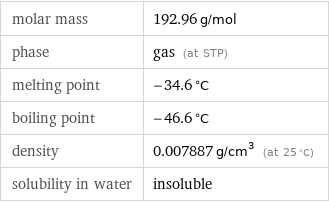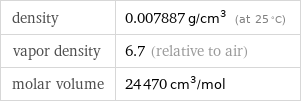Input interpretation

selenium hexafluoride
Chemical names and formulas

formula | F_6Se name | selenium hexafluoride alternate names | hexafluoridoselenium | selenium(6+) fluoride | selenium fluoride | selenium(VI) fluoride mass fractions | F (fluorine) 59.1% | Se (selenium) 40.9%
Lewis structure

Draw the Lewis structure of selenium hexafluoride. Start by drawing the overall structure of the molecule: Count the total valence electrons of the fluorine (n_F, val = 7) and selenium (n_Se, val = 6) atoms: 6 n_F, val + n_Se, val = 48 Calculate the number of electrons needed to completely fill the valence shells for fluorine (n_F, full = 8) and selenium (n_Se, full = 8): 6 n_F, full + n_Se, full = 56 Subtracting these two numbers shows that 56 - 48 = 8 bonding electrons are needed, which are already accounted for in the structure. Note that the valence shell of selenium has been expanded to 6 bonds. After accounting for the expanded valence, there are 6 bonds and hence 12 bonding electrons in the diagram. Lastly, fill in the remaining unbonded electrons on each atom. In total, there remain 48 - 12 = 36 electrons left to draw: Answer: | |
Basic properties

molar mass | 192.96 g/mol phase | gas (at STP) melting point | -34.6 °C boiling point | -46.6 °C density | 0.007887 g/cm^3 (at 25 °C) solubility in water | insoluble
Units

Gas properties (at STP)

density | 0.007887 g/cm^3 (at 25 °C) vapor density | 6.7 (relative to air) molar volume | 24470 cm^3/mol
Units

Thermodynamic properties

specific heat capacity c_p | gas | 0.5727 J/(g K) molar heat capacity c_p | gas | 110.5 J/(mol K) specific free energy of formation Δ_fG° | gas | -5.27 kJ/g molar free energy of formation Δ_fG° | gas | -1017 kJ/mol specific heat of formation Δ_fH° | gas | -5.789 kJ/g molar heat of formation Δ_fH° | gas | -1117 kJ/mol molar heat of fusion | 4.6 kJ/mol | specific heat of fusion | 0.02384 kJ/g | critical temperature | 350 K | (at STP)
Chemical identifiers
(F)(F)(F)F InChI identifier | InChI=1/F6Se/c1-7(2, 3, 4, 5)6 Gmelin number | 68800 RTECS number | VS9450000](../image_source/281d6739ce8ca56abfd27d03d804b6c3.png)
CAS number | 7783-79-1 PubChem CID number | 24558 SMILES identifier | F[Se](F)(F)(F)(F)F InChI identifier | InChI=1/F6Se/c1-7(2, 3, 4, 5)6 Gmelin number | 68800 RTECS number | VS9450000
NFPA label

NFPA label

NFPA health rating | 3
Toxicity properties

RTECS classes | other